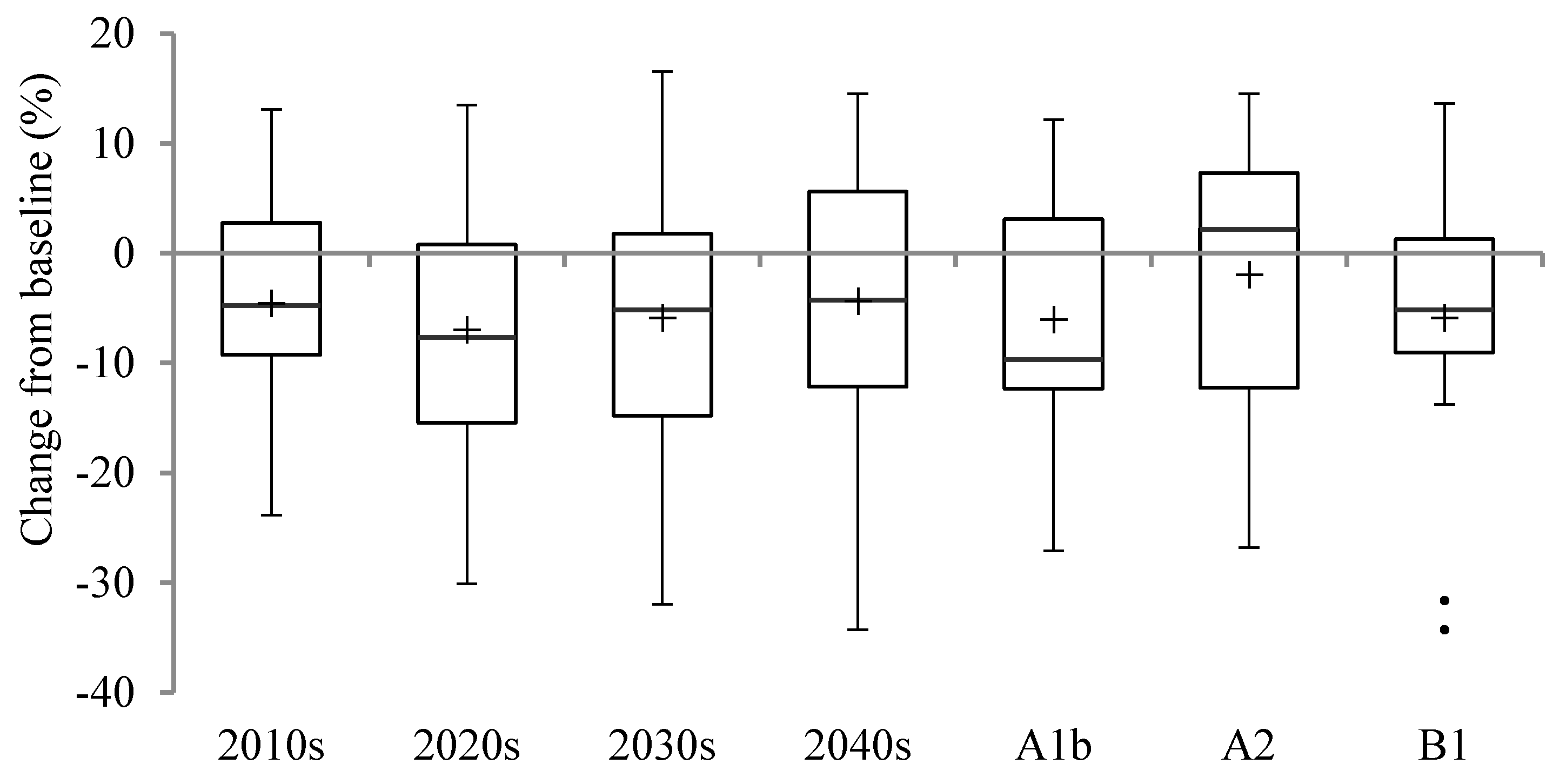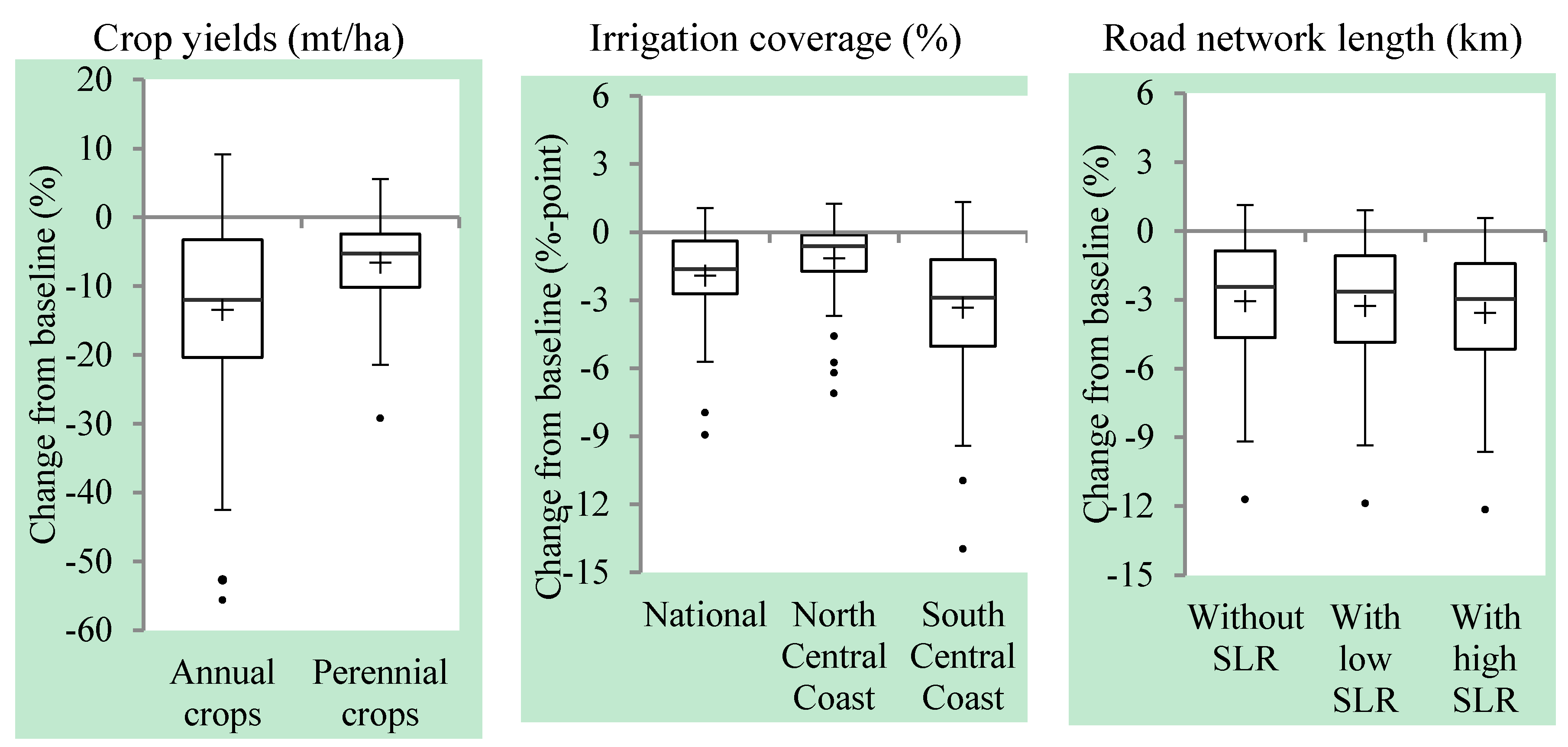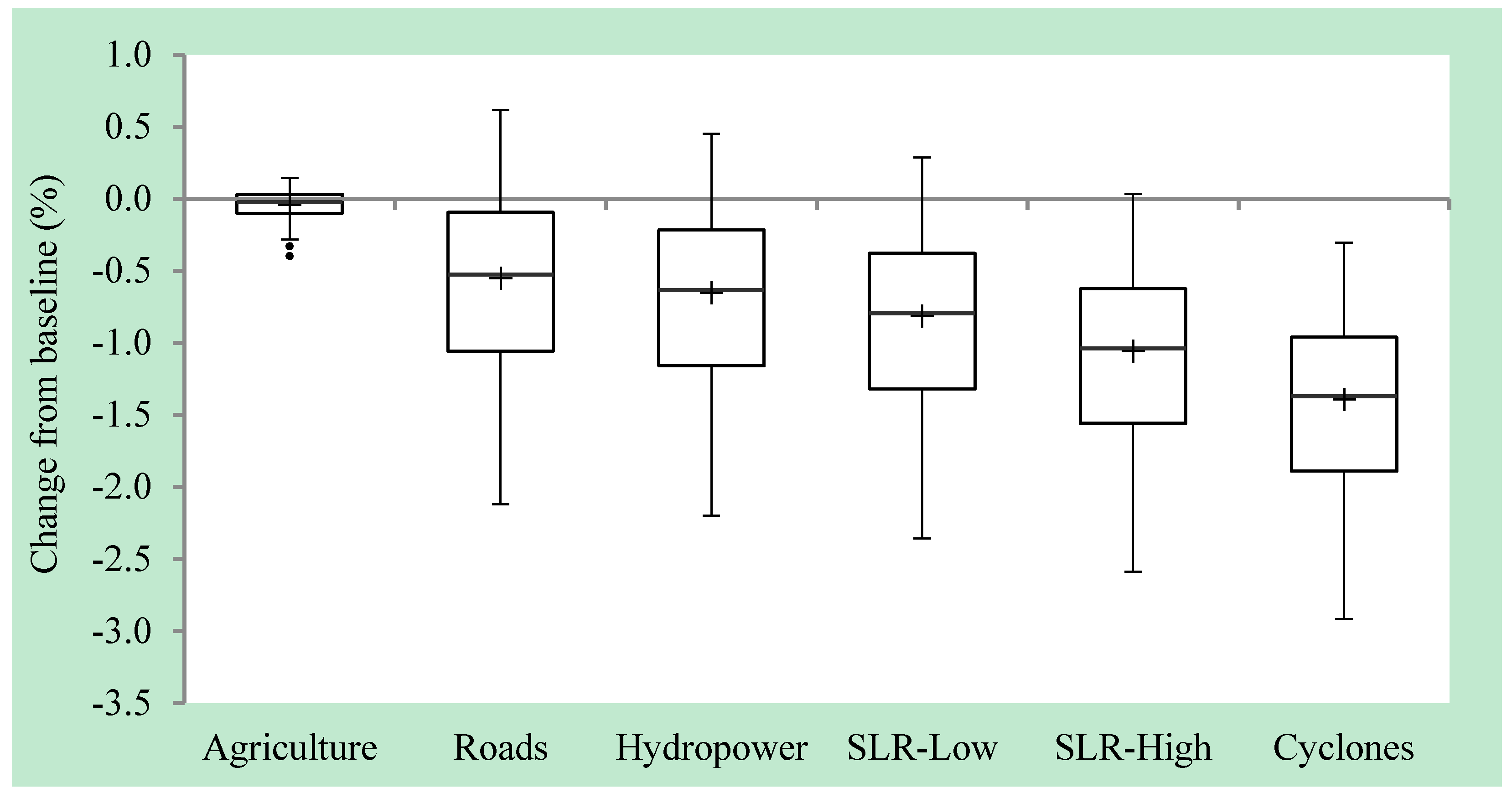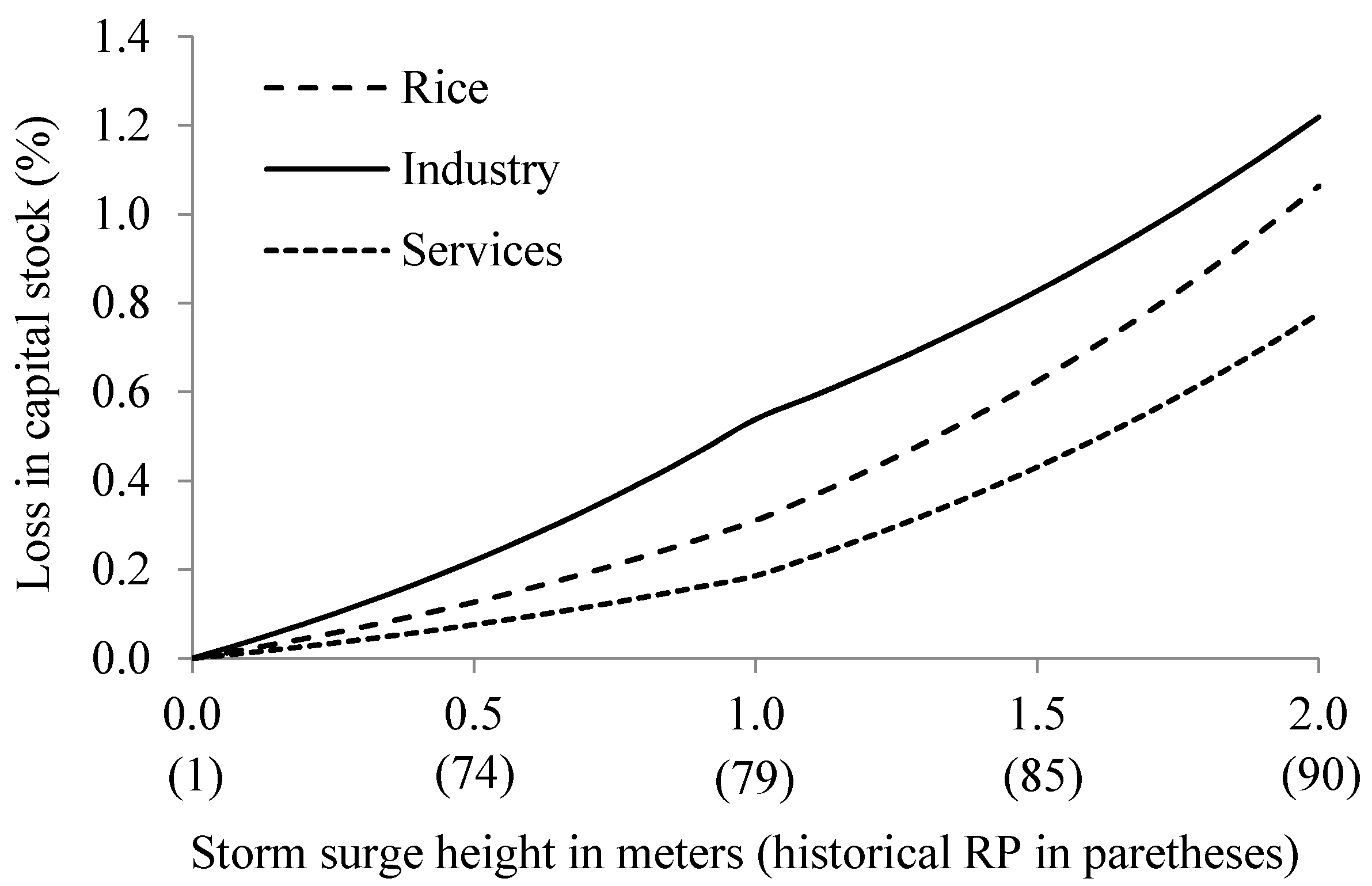4.2. Climate Change Scenarios
Figure 4 reports the deviation in average real GDP across the climate projections for the period 2046–2050 (relative to the baseline). The average is reported in order to limit the implications of shocks during a particular year. Note that the impacts of each transmission channel are cumulative from left to right in the figure. In other words, the
Roads scenario includes the effects of the
Agriculture scenario; the
Hydropower scenario includes the effects of both the
Roads and
Agriculture scenarios; and so on until the
Cyclone scenario, which includes all transmission channels. The sector level climate change shocks imposed on the CGE model are summarized in
Table 1.
Figure 4.
Deviation in average real GDP from baseline during 2046–50 due to climate change. Scenarios are cumulative from left to right. Note: CGE model results. Dots show outliers.
Figure 4.
Deviation in average real GDP from baseline during 2046–50 due to climate change. Scenarios are cumulative from left to right. Note: CGE model results. Dots show outliers.
Table 1.
Climate change scenarios.
Table 1.
Climate change scenarios.
| Scenario | Description of Impacts |
|---|
| 1 | Agriculture | Projected temperature and precipitation changes on crop yields (from CLICROP) combined with changes in irrigated land area based on unmet irrigation demands (from CLIRUN). |
| 2 | Roads | Changes in temperature and precipitation and flood frequency and severity on road network length (from CLIROAD). |
| 3 | Hydropower | Streamflow changes on the generation capacity of hydropower installations (from IMPEND) |
| 4 | SLR-Low | Incremental crop land losses and infrastructure damages from a linear sea level rise reaching 16 cm by 2050. |
| 5 | SLR-High | As above but with sea levels rising by 38 cm by 2050. |
| 6 | Cyclones | Probabilistic cyclone strikes on coastal regions with only the incremental impacts caused by higher sea levels imposed as a climate change shock. |
Beginning with the
Agriculture scenario, we find the implication of climate change to be fairly small when the land losses caused by SLR are excluded. In other words, only the implications of the yield shocks and unmet irrigation demands are imposed (see
Figure 3). The implications of these shocks for the national economy and for growth are modest for two reasons. First, the shocks themselves are not particularly large in most instances. Second and importantly, agriculture’s share of GDP falls in the baseline and remains strictly between 7 and 8 percent of GDP across all climate change projections by about 2050. Since agriculture’s contribution to the economy in the baseline declines regardless of climate change (a strong empirical regularity), variations or reductions in agricultural GDP have an increasingly muted effect on the national economy and overall economic growth rates.
In the
Roads scenario depicted in
Figure 4, the implications of climate change become more pronounced. Although climate change sometimes produces positive outcomes, they are more likely to be negative at a national scale. These implications are driven by results from the road infrastructure model (excluding infrastructure lost due to SLR).
Figure 3 summarized the distribution of changes in road network length relative to the baseline scenario. As indicated earlier, the road infrastructure model is fully integrated within the CGE model, with road network length directly influencing the rate of total factor productivity (TFP) growth for the transport sector. In addition, investment in new roads is assumed to move proportionately with growth in government spending. As a result of these interactions, road network length differs across scenarios.
Degradation or destruction of road infrastructure is different from agricultural yield impacts because the effects on infrastructure endure. Once a road is washed away, the negative effect remains until the road is rebuilt. However, with constant resources allocated to roads, reconstruction of a section of road that is washed away due to heavy rainfall or flooding implies fewer resources available for construction of new roads or regular rehabilitation of existing roads. Hence, climate change influences the rate of accumulation of the road stock, which in turn influences the rate of productivity growth in the transport sector. Because rates of accumulation are influenced, the effects compound over time and can become relatively large. In contrast, for agriculture, climate change influences production in a given year, but not necessarily rates of growth in productive capacity through time. For example, if the temperature rises inherent in climate change intensify the effects of a substantial precipitation shortfall, production will decline, potentially very substantially; however, if, in the subsequent year, growing conditions are favorable, then production will snap back. For these reasons, the incremental impact of climate change is larger for the Roads scenario.
The
Hydropower scenario includes changes in electricity generation due to changes in streamflow. As discussed in
Section 2, impacts on hydropower production are essentially centered about zero in the 2040s. However, in the 2020s and 2030s, when hydropower represents a larger share of total electricity supply, the impacts tend to be negative. The effect is to slightly reduce growth over the period, resulting in a slight reduction in GDP for the median climate projection during the period 2046–2050. It is interesting to note that maximum GDP across all climate scenarios is reduced in hydropower relative to roads. Recall that dry scenarios are typically favorable to roads, but would not be favorable to hydropower production.
The impacts of SLR are negative across all scenarios and shift the distribution of GDP outcomes downward. We assume that SLR is uncorrelated with particular GCM/SRES pairings (
i.e., the same SLR shocks are applied to all climate projections). The two principal drivers of losses from SLR are loss of agricultural land and loss of road infrastructure. As mentioned earlier, one meter SLR is an extreme scenario for climate projections until 2050 (but perhaps a less extreme one for 2100). Following Neumann
et al. [
8], we assume that climate change is expected to deliver at most 0.38 m of SLR by 2050. However, elevation data for Vietnam was available at one meter steps. It is, therefore, impossible to analyze the exact impacts of SLR to 2050 without additional assumptions. We assume that, with 0.38 m of SLR, 38 percent of the area that would be submerged by one meter of SLR is assumed to be submerged. We also assume that this area constitutes principally agricultural land and road infrastructure. Other forms of coastal capital, including machines and permanent structures, are assumed to be less affected because they can either be relocated or placed on higher ground. Based on these assumptions, the scenario
SLR-High is proportionally worse than
SLR-Low.
The Cyclone scenario considers the marginal impact of cyclones relative to the baseline. We assume that there is no change in the frequency or intensity of cyclone strikes from what was observed in the historical record. Much of the damage from cyclone strikes is a function of wind velocity; however, this is held constant between the baseline and the climate change scenarios. As a result, the marginal impact of cyclones due to climate change is restricted to the interactions between storm surge and SLR. SLR of 0.38 m causes the storm surge to extend further inland and increases the depth of submersion in affected areas.
Since larger storms result in more powerful surges and a greater area inundated, we assume that marginal damages increase non-linearly with the power of the storm. This is illustrated in
Figure 5, which shows the marginal loss of capital stock in economic sectors associated with cyclone strikes of different historical return periods (RP). The higher a cyclone’s RP, the less frequent but more severe it is. The figure shows how a two meter storm surge is an RP90 event,
i.e., a cyclone of this severity or greater is expected only once every 90 years. Moreover, the figure shows how 0.38 m of SLR significantly increases the effective return period of historical storms by 2050. Cyclone events are drawn randomly each year across the 56 GCM/SRES pairings. As a result, we expect to see some strong cyclone activity in at least one GCM/SRES pairing in each year. While mean effects remain small even out to 2050 (about 0.1 percent or 1/1000 of the stock of capital lost), losses from relatively larger cyclone events are much more significant—at 1.2 percent of capital stock lost during a single 1-in-90 year storm surge.
Figure 5.
Marginal damages to capital stock due to storm surge and cyclones. Source: Authors’ calculations using results from Neumann
et al. [
8].
Figure 5.
Marginal damages to capital stock due to storm surge and cyclones. Source: Authors’ calculations using results from Neumann
et al. [
8].
The capital damages from cyclones shifts downward the distribution of GDP outcomes. Nevertheless, cyclones’ total effects on economic growth are not large relative to the full projected GDP of Vietnam. The
SLR-Low scenario represents the least strong distribution of impacts, considering all impact channels as well as low SLR. As shown in
Figure 4, average GDP during 2046–2050 is reduced by between 0.3 and 3.0 percentage points, with the majority of outcomes between 1.0 and 2.0 percent. With high SLR and cyclones (
i.e.,
Cyclone scenario), the level of GDP in the period 2046–2050 is between 1.0 and 3.5 percent lower. These results are broadly consistent with World Bank [
15].
Since growth is a cumulative process, the reported reductions in GDP levels translate into small reductions in average annual GDP growth rates over the simulation period. In the Cyclone scenario, the average annual GDP growth rate is reduced by between 0.02 percentage points and 0.10 percentage points. In other words, if the expected average baseline growth rate without climate change is 5.4 percent per annum, then the growth rate would be expected to be between 5.30 and 5.38 percentage points. In sum, climate change represents an additional challenge for future economic development in Vietnam. However, the challenge is not insurmountable in the time frame considered. Other factors will be more influential in determining economic growth rates out to about 2050.
Vietnam’s GDP is expected to exceed US$500 billion by 2050, which means that the losses caused by climate change are large in absolute terms.
Figure 6 illustrates the net present value of losses over the period 2007–50, measured in terms of the difference in GDP at factor cost between the climate change scenarios and the baseline. The net present value is obtained using a 5 percent discount rate. Taking the range between the most favorable outcome of the
SLR-Low scenario and the least favorable outcome of the
Cyclone scenario, the net present value of losses ranges from about zero to around US$40 billion (measured in real 2007 prices). The majority of GDP losses are grouped within the range of US$6–15 billion. These losses provide clear incentives for adaptation policies designed to reduce climate change damages. Moreover, our findings suggest that there is a window of opportunity for Vietnam to benefit from preemptive action.
Figure 6.
Net present value of total GDP losses during 2040s (shown as negative values) due to climate change. Note: CGE model results. Five per cent discount rate is applied. Scenarios are cumulative from left to right. Dots show outliers.
Figure 6.
Net present value of total GDP losses during 2040s (shown as negative values) due to climate change. Note: CGE model results. Five per cent discount rate is applied. Scenarios are cumulative from left to right. Dots show outliers.
Finally,
Figure 7 reports the net present value of GDP losses for the
Cyclone scenario by decade and global emissions scenario. Even though these values are discounted to 2007 (
i.e., the base year for our analysis), the later decades are found to contribute much more to the net present value of total losses than earlier decades. Moreover, climate change impacts are expected to be more severe after 2050 and so our results emphasize the need to prepare early for gradually more severe climate impacts.
Figure 7.
Net present value of total GDP losses in the Cyclone Scenario (shown as negative values). Note: CGE model results. Five per cent discount rate is applied. The decadal box and whisker plots employ results from all 56 GCMs employed for the associated decade. The plots labelled A1b, A2 and B1 show results across all decades for GCMs associated with these emission scenarios. Dots show outliers.
Figure 7.
Net present value of total GDP losses in the Cyclone Scenario (shown as negative values). Note: CGE model results. Five per cent discount rate is applied. The decadal box and whisker plots employ results from all 56 GCMs employed for the associated decade. The plots labelled A1b, A2 and B1 show results across all decades for GCMs associated with these emission scenarios. Dots show outliers.












